So, when I click and drag a Path2D circle on my JPanel, it is resizing. The problem is that when I initially click-and-drag it, the circle jumps to a smaller size, but then resized correctly as you click and drag. The easiest way to demonstrate is to run the runnable code below.
I know I need to fix this code:
@Override
public void mouseDragged(MouseEvent e) {
int mouseX = e.getX();
int mouseY = e.getY();
if (resizing) {
System.out.println("resizing");
Rectangle bounds = shapes.get(currentIndex).getBounds();
int shapeX = bounds.x;
int shapeY = bounds.y;
shapes.get(currentIndex).reset();
shapes.get(currentIndex).append(
new Ellipse2D.Double(shapeX, shapeY, mouseX
- shapeX, mouseX - shapeX), true);
repaint();
}
}
I'm not sure how, though. I am clicking on the outer edge of the circle, and then I am setting the length and width of the bounds of the circle to where the new mouse point is...but what I need to do is the the outer edge of the circle's coordinates to the new mouse points. Any ideas on how to compute the correct point?
Full Code
import java.awt.BasicStroke;
import java.awt.Color;
import java.awt.Cursor;
import java.awt.EventQueue;
import java.awt.Graphics;
import java.awt.Graphics2D;
import java.awt.Panel;
import java.awt.Point;
import java.awt.Rectangle;
import java.awt.event.MouseAdapter;
import java.awt.event.MouseEvent;
import java.awt.geom.Ellipse2D;
import java.awt.geom.Path2D;
import java.awt.geom.Point2D;
import java.awt.geom.Rectangle2D;
import java.util.ArrayList;
import java.util.List;
import javax.swing.JFrame;
import static javax.swing.JFrame.EXIT_ON_CLOSE;
import javax.swing.JPanel;
import javax.swing.UIManager;
import javax.swing.UnsupportedLookAndFeelException;
public class Editor {
public static void main(String[] args) {
new Editor();
}
public Editor() {
EventQueue.invokeLater(new Runnable() {
@Override
public void run() {
try {
UIManager.setLookAndFeel(UIManager
.getSystemLookAndFeelClassName());
} catch (ClassNotFoundException | InstantiationException
| IllegalAccessException
| UnsupportedLookAndFeelException ex) {
ex.printStackTrace();
}
JFrame frame = new UMLWindow();
frame.setDefaultCloseOperation(JFrame.EXIT_ON_CLOSE);
frame.setBounds(30, 30, 1000, 700);
frame.getContentPane().setBackground(Color.white);
frame.setVisible(true);
frame.setLocationRelativeTo(null);
frame.setVisible(true);
}
});
}
public static class UMLWindow extends JFrame {
Shapes shapeList = new Shapes();
Panel panel;
private static final long serialVersionUID = 1L;
public UMLWindow() {
addMenus();
panel = new Panel();
}
public void addMenus() {
getContentPane().add(shapeList);
setSize(300, 200);
setLocationRelativeTo(null);
setDefaultCloseOperation(EXIT_ON_CLOSE);
shapeList.addCircle(100, 100);
}
}
// Shapes class, used to draw the shapes on the panel
// as well as implements the MouseListener for dragging
public static class Shapes extends JPanel {
private static final long serialVersionUID = 1L;
private List<Path2D> shapes = new ArrayList<Path2D>();
int currentIndex;
private Point mousePoint;
public Shapes() {
MyMouseAdapter myMouseAdapter = new MyMouseAdapter();
addMouseListener(myMouseAdapter);
addMouseMotionListener(myMouseAdapter);
}
public void addCircle(int width, int height) {
Path2D circ = new Path2D.Double();
circ.append(new Ellipse2D.Double(442, 269, width, height), true);
shapes.add(circ);
repaint();
}
@Override
protected void paintComponent(Graphics g) {
super.paintComponent(g);
Graphics2D g2 = (Graphics2D) g;
g2.setStroke(new BasicStroke(2));
for (Path2D shape : shapes) {
g2.setColor(Color.BLACK);
g2.draw(shape);
}
}
public Rectangle2D getActiveBounds(float angel, Rectangle bounds) {
Point2D p = getPointOnEdge(angel, bounds);
return new Rectangle2D.Double(p.getX() - 4, p.getY() - 4, 8, 8);
}
public Point2D getPointOnEdge(float angel, Rectangle bounds) {
float radius = Math.max(bounds.width, bounds.height) / 2;
float x = radius;
float y = radius;
double rads = Math.toRadians((angel + 90));
// Calculate the outter point of the line
float xPosy = (float) (x + Math.cos(rads) * radius);
float yPosy = (float) (y + Math.sin(rads) * radius);
return new Point2D.Float(xPosy + bounds.x, yPosy + bounds.y);
}
class MyMouseAdapter extends MouseAdapter {
Boolean hovering = false;
Boolean resizing = true;
@Override
public void mouseMoved(MouseEvent e) {
mousePoint = e.getPoint();
for (int i = 0; i < shapes.size(); i++) {
Path2D shape = shapes.get(i);
Rectangle2D bottomRight = getActiveBounds(-45,
shape.getBounds());
if (mousePoint != null) {
if (bottomRight.contains(mousePoint)) {
Cursor cursor = Cursor
.getPredefinedCursor(Cursor.SE_RESIZE_CURSOR);
setCursor(cursor);
hovering = true;
} else {
Cursor cursor = Cursor
.getPredefinedCursor(Cursor.DEFAULT_CURSOR);
setCursor(cursor);
hovering = false;
}
}
}
repaint();
}
@Override
public void mousePressed(MouseEvent e) {
if (hovering) {
resizing = true;
System.out.println("Starting to resize");
}
}
@Override
public void mouseDragged(MouseEvent e) {
int mouseX = e.getX();
int mouseY = e.getY();
if (resizing) {
System.out.println("resizing");
Rectangle bounds = shapes.get(currentIndex).getBounds();
int shapeX = bounds.x;
int shapeY = bounds.y;
shapes.get(currentIndex).reset();
shapes.get(currentIndex).append(
new Ellipse2D.Double(shapeX, shapeY, mouseX
- shapeX, mouseX - shapeX), true);
repaint();
}
}
@Override
public void mouseReleased(MouseEvent e) {
if (resizing) {
System.out.println("Done resizing");
resizing = false;
}
}
}
}
}
